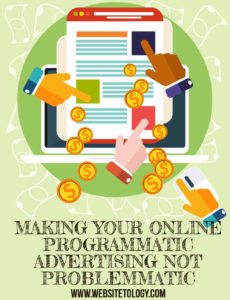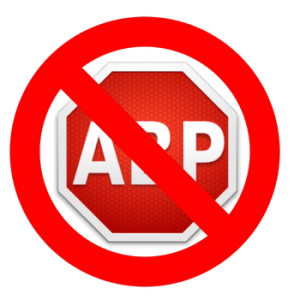Thinking of jumping in on buying online ads? Or letting advertisers put their ads on your site? Think online advertising is cheaper than “traditional media” like TV, newspapers, billboards and direct mail?
 Buyer beware, and not just for the reasons cited in this NY Times article:
Buyer beware, and not just for the reasons cited in this NY Times article:
As of a few weeks ago, advertisements for JPMorgan Chase were appearing on about 400,000 websites a month. It is the sort of eye-popping number that has become the norm these days for big companies that use automated tools to reach consumers online.
Now, as more and more brands find their ads popping up next to toxic content like fake news sites or offensive YouTubevideos, JPMorgan has limited its display ads to about 5,000 websites it has preapproved, said Kristin Lemkau, the bank’s chief marketing officer. Surprisingly, the company is seeing little change in the cost of impressions or the visibility of its ads on the internet, she said. An impression is generally counted each time an ad is shown.
The change illustrates the new skepticism with which major marketers are approaching online ad platforms and the automated technology placing their brands on millions of websites. In recent years, advertisers have increasingly shunned buying ads on individual sites in favor of cheaply targeting groups of people across the web based on their browsing habits, a process known as programmatic advertising — enabling, say, a Gerber ad to show up on a local mother’s blog, or a purse in an online shopping cart to follow a person around the internet for weeks.
Source: Chase Had Ads on 400,000 Sites. Then on Just 5,000. Same Results. – The New York Times
Sure, keeping your ads off objectionable sites is a noble reason for refining the sites where your ad appears, but the reality is, having your ad appear on a clickbait site is unlikely to get you a conversion (sale).
If it wasn’t profitable to build clickbait sites to just serve up ads, they wouldn’t exist. If that’s what you want to do, we can show you how to be the scum of the earth, better in our seminar.
Think about the ads you see online- and how many you interact with (assuming you aren’t part of the 30% of internet users who have enabled adblocking in your browser). If you are like a lot of people, it takes a whole lot to make you click. How many people do you know who say I’m going online to look at ads?
The ads that are potentially most likely to be seen? Video pre-roll, the ad that runs before your video, comes in two flavors- must watch and skippable after x seconds. Video pre-roll has to have amazingly compelling intro to get you to watch it through- unless, of course it’s targeted so well that your questions may be answered in the commercial. Here’s an award winning pre-roll campaign for an agency trying to get your attention-
And here is a Cannes Award winning campaign for Geico that you can’t stop watching, but, it may or may not get you to buy car insurance from them.
The thing both these spots get right- is realizing you don’t really want to watch a pre-roll commercial, so they’ve made it interesting. It’s not a TV spot- it’s a youtube spot- built for the platform and working hard to not be intrusive.
As to all the other ads websites, most you can ignore. Easily. Even in your Facebook feed, how often do you click on an ad?
Here are some tips to make sure you have a better chance on conversion.
- Remarketing to people who’ve been on your site already is usually a better bet. You know these ads well- you’ve gone to look at something at Amazon- and may have even purchased it, but it keeps showing up on your feed forever. Hint: better bet is to show ads of how to use “it” or accessories for “it” than to keep hammering the ad of “it”- unless you are offering a discount (which may tick your customers off if they bought it for more on your site already- so have a price guarantee). The basic rule of sales applies- people do business with people they know- so these ads tend to preform well.
- Advertise to people who know someone who is your happy customer. While it’s hard to get people to post “Hey, I just bought “it” at your store, without a potential reward, it can happen. More likely, is advertising to people who are similar to people you’ve already sold to. Facebook allows you to upload a customer list and they will find people who are friends of the people who have bought from you in the past.
- Advertise to people who are like the people you’ve sold to. This is also a Facebook option, using their software you can match demographics and geography and other factors to your customer list and advertise to people who are more likely to buy from you.
- And maybe the least intuitive ad- isn’t an ad at all. Create informational videos, instructional videos, or reviews and target people by their interests. Think about your research before buying- do you look for reviews? Watch comparison video’s, unboxing, assembly? This kind of content can solve a buyers questions- and possibly drive them to buy more than an ad. Target the ads carefully, because ideally, these types of posts should work organically, without a ton of ad dollars.
For most advertisers dipping into “programmatic” the numbers sound amazing that are offered by programmatic networks, what’s amazing is the verification of actual display of ads is self reported, not audited like conventional media for distribution, insertion, reach and frequency. It’s the wild west of advertising accountability out there, which means it’s really up to you to figure out how to track your ad spend for effectiveness. There are all kinds of ways to do this, that add a level of complexity, but can also help you refine and improve your ad buys.
We explain some of these tools in our Websitetology seminar, but if you have further questions, you can always call and talk to us about how to most effectively guarantee that your programmatic isn’t problemmatic.
One of the things we teach in our Websitetology Seminar is how Google sets the pricing for buying adwords and how they appear on a search page. Most of us never really think about how all this content we’re looking at is “free” – we just surf the web and curse ads and ignore them.
But, the reality is- those ads are what pays for the content you look at. We may get upset that we feel we’re being tracked or fed a steady stream of remarketing, but until recently, there wasn’t a way to simply enable an affordable system of “micropayments” to pay for your browsing. Every systems transaction cost was more than the cost of the micropayment.
Enter “Contributor” by Google. Set a bid on how much you are willing to pay to avoid seeing ads each month, make a payment arrangement- and browse away:
When you visit a participating website, part of your contribution goes to the creators of that site. As a reminder of your support, you’ll see a thank you message – often accompanied by a pixel pattern – where you might normally see an ad.
Source: Contributor by Google
Forget the adblock- and support the content creators that make all the great stuff you surf everyday. This probably won’t replace a paywall anytime soon, but, it is a start to a better browsing experience.
Every blog starts humble- well, at least most do. If you have a niche, and do a great job, well, next thing you know, you’ve got a million dollar business.
Here is what 247WallSt.com decided were the top 25 blogs- based on their financial value- take a look:
financial values on blogs.
Gawker, Huffington Post and Drudge report are at the top of the heap- but don’t let that stop you. There are opportunities untapped- just find your niche and jump in.


